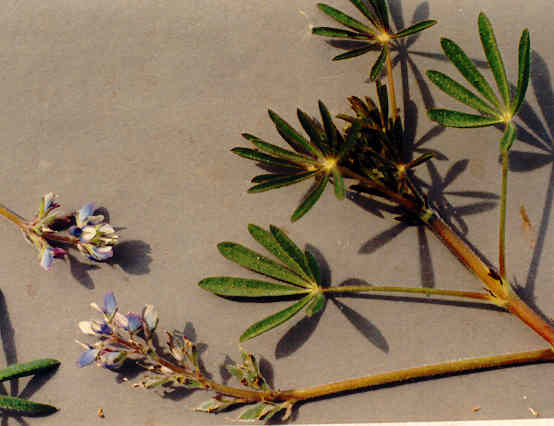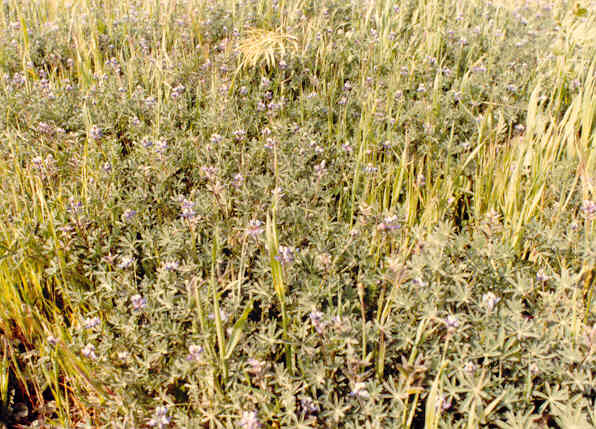
Lupinus bicolor Lindl.
=Lupinus bicolor ssp. umbellatus
 |
Lupinus bicolor Lindl.=Lupinus bicolor ssp. umbellatus
Fabaceae (Pea Family)NativeMiniature LupineCalif. Miniature Lupine |
March Photo
Plant Characteristics:
Annual, the stems, 1-several from the base, erect to decumbent, 1-4 dm. tall,
villous throughout, petioles 2-7 cm. long; lfts. 5-7 oblanceolate to cuneate,
1-3 cm. long; peduncles 3-7 cm. long; racemes 1-7 cm. long, with 3-9 whorls;
pedicels 1.5-3 mm. long; bracts subulate, deciduous, 4-6 mm. long; lower
calyx-lip deeply cleft, the teeth 1-5 mm. long; banner 6-9 mm. long, rounded at
apex, obovate, blue with cent. light spot; keel with a slender acumen, ciliate
on upper edge near tip; pod strigose, 1.5-2 cm. long.
Habitat:
V. Grassland, Joshua Tree Wd., Yellow Pine F.; Mt. valleys along w. edge
of deserts, San Diego Co. n. March-June.
Name:
Latin, from lupus, a wolf,
because of an old idea that lupines rob the soil.
Bicolor refers to the blue and
white of the flowers. (Dale 113).
N.L., umbellatus, with umbels.
(Jaeger 303). Umbellatus
with flower clusters like an umbel. In
this subspecies the flowers are borne more like an umbel than like a raceme or
spike that is typical of lupines. (John
Johnson).
General:
Occasional in the study area. The
photographed specimen was found at the north end of Backbay Dr., on a small
bench, between the road and the bluff. (my comments).
The oldest known viable seeds, discovered in l967 frozen in a lemming
burrow, are from an arctic Lupine, estimated at 10,000 years old; when planted
they germinated in 48 hours. The
Miniature Lupine and the California Poppy, Eschscholzia
californica, are common companions, the blue cast given to fields by the
Lupine complementing perfectly the fiery orange of the Poppy.
(Spellenberg 502-503).
Tea from the leaves or seeds of Lupinus
spp. has been used for bladder trouble and failure to urinate.
(Heizer & Elsasser 131).
After fertilization has taken place, the white in these blossoms turns a
deep red, and this admixture gives the general lilac tone to the mass.
(Parsons 308). The
Miwok Indians of central California ate Lupinus bicolor as greens. (Campbell 140).
Subspecies umbellatus not
recognized in the new Jepson Manual. (Hickman,
Ed. 1339).
Text Ref:
Dale 112; Hickman, Ed. 628; Munz, Calif.
Flora 815; Munz, Flora So. Calif.
454; Roberts 24.
Photo Ref:
Mar 2 85 # 21; Mar 3 85 # 3.
Identity: by R. De Ruff,
confirmed by F. Roberts.
Computer Ref: Plant Data 76.
Have plant specimen.
Last edit 1/17/03
 |
March Photo